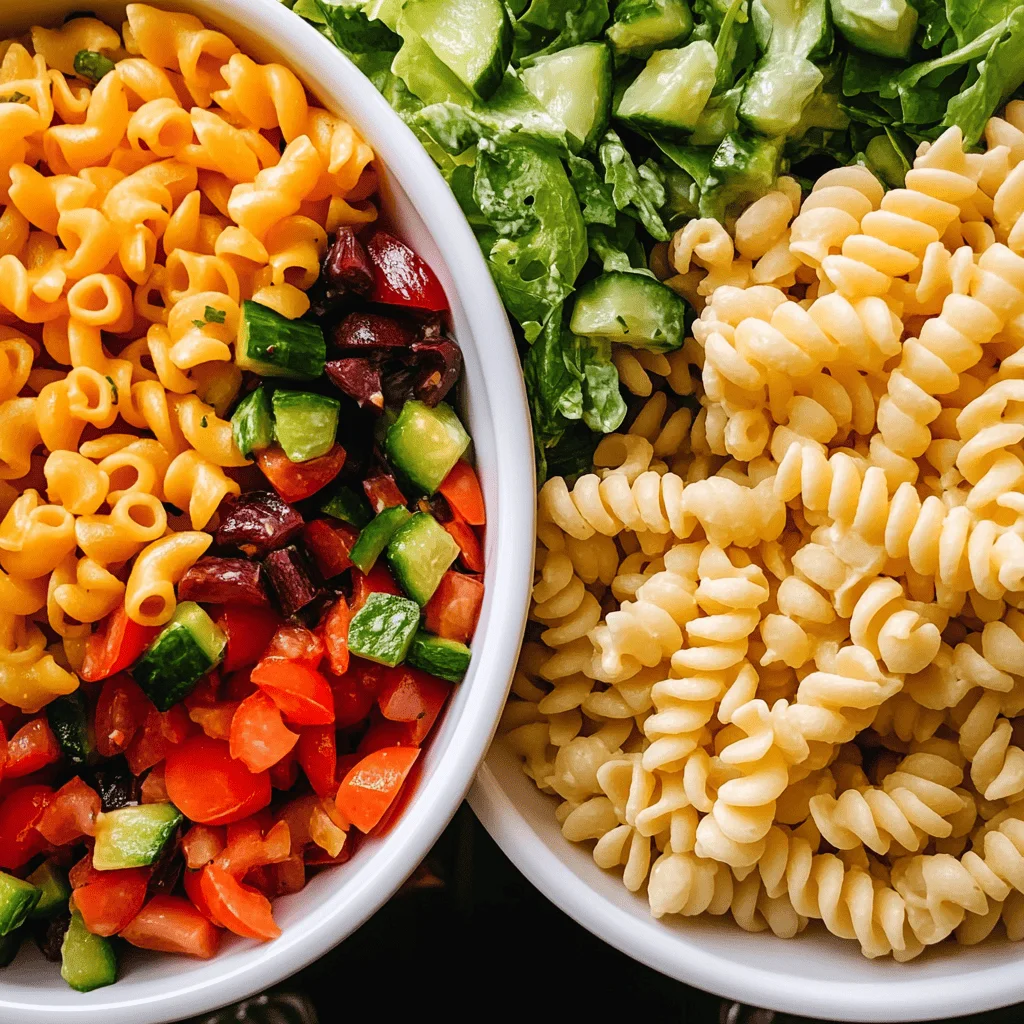When it comes to classic side dishes that evoke memories of summer cookouts, picnics, and holiday feasts, pasta salad and macaroni salad frequently make an appearance. Despite their similarities, many people often wonder, What’s the difference between pasta salad and macaroni salad? Although these two salads share common features, they have distinct characteristics that set them apart. This article will explain the key differences, from the type of pasta used to the variety of dressings and regional twists that define each dish.
Introduction to Pasta Salad and Macaroni Salad
Pasta salad and macaroni salad are both delightful dishes that usually feature cooked pasta as the base. Both salads are served chilled, making them perfect for warm weather. While both are side dishes, each offers unique flavors and textures. The difference between the two often lies in the pasta type, dressing, and other ingredients added.
To answer the question, What’s the difference between pasta salad and macaroni salad?, let’s try the origins and characteristics of each dish.
Defining Pasta Salad: Origins and Characteristics
Pasta salad is a flexible dish, offering endless variations. It likely originated in Europe and has evolved over time, becoming popular in the United States as well. The basic concept involves combining cooked pasta with a variety of vegetables, proteins, and dressings. Pasta salad can be both light and filling, and its adaptability makes it perfect for any occasion.
One of the defining features of pasta salad is the pasta itself. While macaroni salad uses elbow macaroni, pasta salad can feature any type of pasta—penne, rotini, fusilli, farfalle, or even shells. The dressing can also vary, from creamy dressings made with mayonnaise to vinaigrettes made with olive oil and vinegar, allowing for a wide range of flavors.
Pasta salad shines at gatherings like barbecues, picnics, and buffets. It pairs well with grilled meats, seafood, and fresh salads. Its versatility makes it easy to customize, so people can adjust the ingredients based on taste or dietary preferences.
Defining Macaroni Salad: Origins and Characteristics
Macaroni salad, in contrast, is a more specific variation of pasta salad. It originated in the United States and became popular in the late 19th century, particularly as a side dish for barbecues, picnics, and holiday gatherings. The key difference lies in the pasta used: macaroni salad uses elbow macaroni, a small, curved pasta that has a unique texture.
The hallmark of macaroni salad is its creamy dressing, traditionally made with mayonnaise. Some variations might add mustard, vinegar, or pickle relish to upgrade the flavor, but the creamy base remains consistent. While macaroni salad can also contain vegetables and proteins, the dressing and macaroni play a more central role in the dish.
Macaroni salad often appears at gatherings where comfort food is favored. It provides a satisfying, rich side dish that complements heavy main courses, such as barbecued meats and fried chicken.
Key Differences Between Pasta Salad and Macaroni Salad
While pasta salad and macaroni salad share common ground, there are several differences that set them apart. Let’s break down the main distinctions.
The Type of Pasta Used
One of the most noticeable differences between pasta salad and macaroni salad is the pasta.
- Pasta Salad: This dish can include various types of pasta, from bow ties (farfalle) to fusilli, penne, or even farfalle. The shape of the pasta can influence the texture and how well it holds the dressing.
- Macaroni Salad: This dish relies on elbow macaroni, a small, curved tube-shaped pasta. The small shape of elbow macaroni allows it to absorb the creamy dressing well, giving it a smooth texture throughout the dish.
The pasta used contributes to the overall texture of each dish. Pasta salad offers more variety, whereas macaroni salad has a uniform texture due to the use of elbow macaroni.
Ingredients and Add-ins
While both pasta salad and macaroni salad feature vegetables and proteins, the specific ingredients often differ.
- Pasta Salad: The ingredients can range from colorful vegetables such as bell peppers, cucumbers, and tomatoes to olives and fresh herbs like basil or parsley. You can also find proteins like chicken, tuna, shrimp, or even bacon in some pasta salad recipes.
- Macaroni Salad: In contrast, macaroni salad usually includes simpler ingredients. Diced celery, onions, and hard-boiled eggs are common. Some variations may include relish or sweet pickles for added tang.
The difference in ingredients between the two salads reflects their overall approach. Pasta salad embraces variety and creativity, while macaroni salad keeps things more traditional and straightforward.
Vegetables: A Difference in Variety
Pasta salad is known for its broad selection of vegetables, which add color, crunch, and flavor.
- Pasta Salad: Typically, pasta salad contains a variety of fresh vegetables like cherry tomatoes, olives, cucumbers, and even roasted vegetables such as zucchini or artichokes. These vegetables contribute to the overall light and refreshing flavor of the salad.
- Macaroni Salad: On the other hand, macaroni salad includes fewer vegetables. The most common vegetables are diced celery, onions, and sometimes sweet peas. The vegetable flavors are usually subtle, with the focus more on the creamy dressing and macaroni itself.
The variety of vegetables in pasta salad provides more complex flavors and textures, while macaroni salad tends to be simpler in terms of its vegetable selection.
Proteins: Meat, Eggs, and Cheese
Both pasta salad and macaroni salad can include proteins, but the options differ between the two dishes.
- Pasta Salad: In pasta salad, you might find proteins like grilled chicken, tuna, bacon, or even chunks of cheese like mozzarella, feta, or parmesan. These proteins provide richness and depth, making the dish more filling.
- Macaroni Salad: Macaroni salad typically includes proteins like hard-boiled eggs, diced ham, or occasionally some chicken. These proteins are often finely chopped to blend ordered with the macaroni and dressing.
Pasta salad tends to offer more protein variety, while macaroni salad typically sticks to a smaller selection of familiar ingredients.
Dressings: Mayonnaise vs. Other Dressings
The dressings used in pasta salad and macaroni salad are one of the major differences that define each dish.
- Pasta Salad: The dressing in pasta salad can be anything from a tangy vinaigrette made with olive oil and vinegar to a rich, creamy dressing made with mayonnaise or yogurt. You can tailor the dressing to match the overall flavor profile you want to achieve, whether it’s tangy, sweet, or herby.
- Macaroni Salad: Macaroni salad always uses a creamy dressing, and mayonnaise is the most common base. Some recipes might add mustard, vinegar, or pickle relish for extra flavor, but the creamy texture remains the same.
The choice of dressing gives each dish its distinct flavor. Pasta salad offers more flexibility in flavor, while macaroni salad emphasizes its rich, creamy base.
Flavor Profiles: How They Differ
The overall flavor of pasta greens and macaroni greens also differs based on their ingredients and dressings.
- Pasta Salad: Pasta salad tends to have a more complex flavor profile. The variety of vegetables, proteins, and dressings combine to create a balance of fresh, tangy, creamy, and sometimes even sweet flavors. Each bite offers different tastes and textures, keeping things interesting.
- Macaroni Salad: The flavor profile of macaroni salad is typically simpler. The creamy mayonnaise dressing dominates, and the addition of mustard or relish introduces tanginess. The flavors are comforting and consistent, making macaroni salad a go-to dish for many.
Regional Variations of Pasta Salad and Macaroni Salad
Both pasta salad and macaroni salad have regional variations that influence the ingredients and preparation.
Pasta Salad Variations Around the World
Pasta salad enjoys popularity in many parts of the world, and each region has its own spin on the dish.
- Italy: Italian pasta salad often includes seasonal vegetables like artichokes, olives, and tomatoes, dressed with olive oil and balsamic vinegar. The use of fresh herbs such as basil and oregano adds authenticity to the dish.
- Greece: A Greek-style pasta salad might feature feta cheese, Kalamata olives, cucumbers, and red onions, with a light olive oil dressing. The Mediterranean flavors bring a fresh twist to the traditional pasta salad.
Popular Macaroni Salad Recipes Across Different Cultures
Macaroni salad is widely enjoyed in many cultures, although its base ingredients often remain similar.
- Hawaii: Hawaiian macaroni salad is a popular variant that includes grated carrots, sweet onions, and a touch of sugar. The creamy dressing often contains a little bit of vinegar to balance the richness.
- Southern U.S.: In the Southern U.S., macaroni salad is sometimes made with boiled eggs, relish, and mustard for added sweetness and tang. These ingredients give the dish a distinctive, comforting flavor.
When to Serve Pasta Salad and Macaroni Salad
Both pasta greens and macaroni greens shine in different contexts. Let’s take a closer look at when to serve each dish.
Pasta Salad: Ideal for Picnics, BBQs, and Buffets
Pasta greens works great for outdoor gatherings such as picnics, barbecues, and buffets. It pairs wonderfully with grilled meats, seafood, and light salads. The cold, refreshing nature of pasta salad makes it the perfect dish to enjoy on a hot summer day.
Healthy Griddle Recipes: A Guide to Delicious and Nutritious Cooking
Macaroni Salad: A Side Dish Staple for Gatherings and Holiday Meals
Macaroni salad often appears at holiday meals, family gatherings, and potlucks. Its rich, comforting flavor makes it an excellent accompaniment to barbecued meats, fried chicken, or sandwiches. Its creamy texture is perfect for pairing with hearty, savory dishes.
Nutritional Differences Between Pasta Salad and Macaroni greens
Both pasta salad and macaroni salad can be satisfying and delicious, but their nutritional content differs based on the ingredients.
Caloric and Macronutrient Breakdown
Macaroni greens tends to be higher in calories because of the mayonnaise dressing, which adds fat and calories. Pasta salad, on the other hand, can be made with lighter dressings like vinaigrettes, offering fewer calories. The pasta and add-ins in each dish contribute to its overall macronutrient content, with pasta salad being more versatile in terms of creating a lighter dish.
Healthier Alternatives and Substitutes
To make either greens healthier, you can replace traditional ingredients with lighter alternatives. For pasta salad, opt for whole-grain or vegetable-based pasta and use a vinaigrette dressing. For macaroni salad, consider using Greek yogurt in place of mayonnaise to cut down on fat while still achieving a creamy texture.
Conclusion
So, What’s the difference between pasta greens and macaroni greens ? While both dishes feature pasta and offer ample room for customization, they differ in key aspects. Pasta greens uses various types of pasta and dressings, offering more flexibility in terms of flavor and texture. Macaroni salad, on the other hand, is simpler, focusing on elbow macaroni and a creamy mayonnaise dressing. Both dishes are great for different occasions, but their distinct ingredients and flavor profiles make each one unique. Whether you prefer a creamy macaroni greens or a vibrant pasta greens , both are sure to be a hit at your next gathering.

